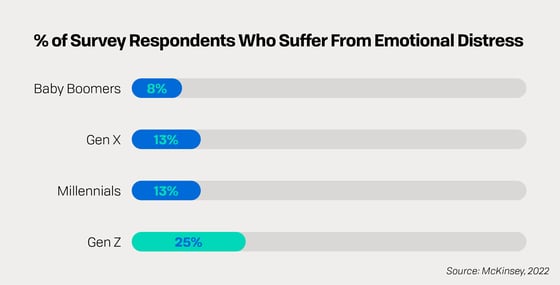There are many factors that go into which college a high school graduate will choose. Location, degree programs, parental influence, and cost are major determinants.
Modern expectations dictate that colleges and universities also must create formidable brands that go beyond their reputation alone. A college or university should have a brand that appeals to different audiences such as current and future students, as well as parents, guardians, and guidance counselors who can all be a part of the decision-making process.
 The students that are entering college now are different from before and universities should approach them in that manner when advertising enrollment and retention. With Gen Z, mental health is in the spotlight more and more as this generation of students is more open than other generations to talking about their feelings of stress. A study on Gen Z and mental health shows that this generation has the most anxiety and depression, the least positive outlook on life, on top of having a hard time paying for food or school.
The students that are entering college now are different from before and universities should approach them in that manner when advertising enrollment and retention. With Gen Z, mental health is in the spotlight more and more as this generation of students is more open than other generations to talking about their feelings of stress. A study on Gen Z and mental health shows that this generation has the most anxiety and depression, the least positive outlook on life, on top of having a hard time paying for food or school.
Institutions that want to increase enrollment may need to update their higher ed marketing strategies to target audiences across generations and stay ahead of the competition. With changing policy and cultural landscapes in how younger generations approach college education, it's more critical than ever for recruiters to pay close attention to their marketing and branding. Here's what institutions can do to drive enrollment and maintain and further their image and reach.
What Makes Higher Ed Marketing Different from General Marketing?
Higher education marketing has several aspects that are often at battle with one another.
For educators and prospective students alike, many value the idea of education and do not like the idea of a degree being a product to sell. Ultimately, "degree as a product" is how Gen Z is seeing it: college enrollment has been steadily declining since the pandemic. 2021 resulted in another year-over-year decline since 2020, representing a 6.6% decrease in eligible students applying to college. While students still crave the traditional college experience, many younger people felt that attending a virtual campus was not worth the price tag, when the modern digital economy allows them to easily find unskilled work or start businesses at home.
The challenges of COVID-19 aside, choosing an educational institution is a major financial and emotional commitment. Other parties are often involved in the decision, typically the student's parents/guardians, and school guidance counselor in some cases. Messaging not only must appeal to students, but to these adult audiences too, those which likely need to be marketed to different than the Gen Z student. Where are these audiences most likely to be reached? How will they find out about your college, and why would they choose to apply there over another school? How can colleges or universities effectively reach a Gen Z audience? These are all questions that are important for marketers to answer.
The customer journey for higher education also simultaneously has several touchpoints and is not a decision made on the sly, like purchasing new jeans. But due to enrollment cycles and most students bee-lining to college out of high school, there is also a very limited time to reach prospective students.
Why Are Higher Ed Marketing Strategies Important for Colleges and Universities?
Just like how attitudes towards higher education have changed, so have forms of outreach.
College marketing hit a peak of $1.2 billion in 2013, declining to about $730 million in advertising alone in the late 2010s. For-profit colleges have an advertising spend of about $400 per student, while nonprofit private college spend roughly $48 per student and public colleges spend $14.
Advertising is not the only method for how to market higher education, although it remains an important part of higher ed marketing strategies. A cohesive digital presence and change in voice is also necessary for colleges and universities to beat the enrollment decline.
College Marketing Trends to Look Out For
- Pivoting to video. Educational institutions have so much information to absorb, and many aspects of campus life and the enrollment process can be made into easily digestible videos.
- Going Virtual: High school students are now learning about colleges virtually through avenues like virtual tours, virtual Q&A sessions, virtual college fairs, and 1-on-1 virtual meetings. Making it important to have a strong online presence and approach to creating connections with potential students whose only interaction with your school might be online.

Becoming more conversational. College marketing of the past often spoke more to parents and educators than prospective students. With Gen Z being notoriously hard to reach, and parents still needing to be appealed to, colleges as a brand have had to become savvier and more conversational on social media.- Working with influencers. Influencers can provide in-depth looks at what life and education is like at your campus, especially if they are current or former students. Influencer marketing is going to become a crucial way to bridge the gap between how colleges have historically been marketed, and how younger audiences are reached today. Instagram, TikTok, and YouTube are all different channels that brands can use leverage influencers.
Media Now Interactive has decades of experience in higher education marketing. Our marketing experts have worked with a variety of targeted digital ads and print media designed to keep applicants' interest in mind and convert them to students.
About the Author
@Janine Pollack, Media Now Interactive Integrated Marketing Director and self-appointed Storyteller in Chief, leads the brands commitment to generating content that informs and inspires. Prior to Media Now, Janine worked with Fortune 500 companies and world-renowned education institutions on numerous research and white papers, podcasts and thought-leadership and education campaigns.



